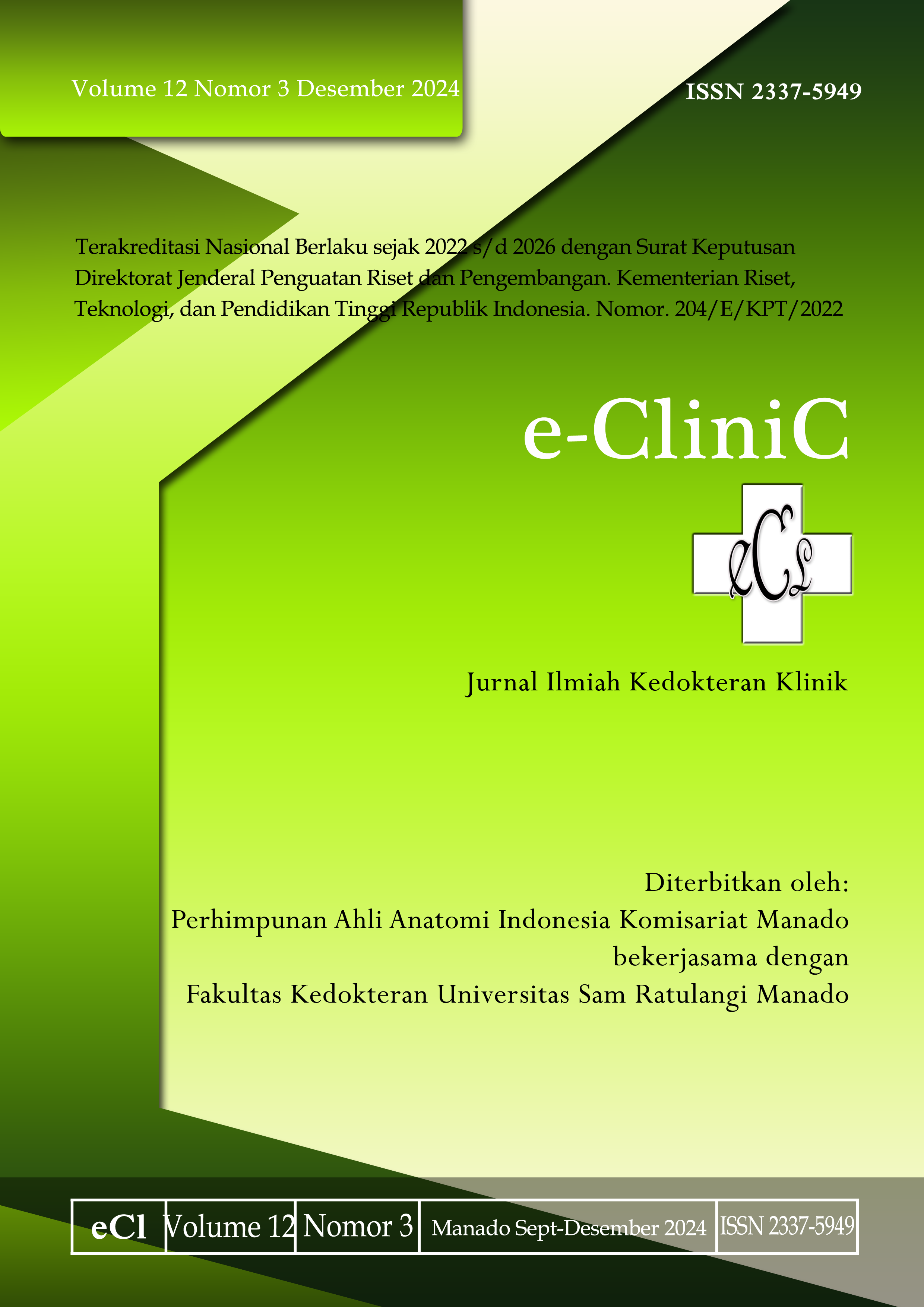Prevalensi Kelainan Refraksi pada Anak Remaja Kelas X di SMA Rex Mundi Manado
DOI:
https://doi.org/10.35790/ecl.v12i3.53529Abstract
Abstract: Uncorrected refractive errors are a leading cause of vision impairment across all age groups. In Indonesia, adolescents aged 15-18 years face the risk of eye health issues due to excessive use of electronic devices, particularly during the COVID-19 pandemic. This study aimed to obtain the prevalence of refractive errors among adolescents. This was a quantitative and descriptive study using a cross-sectional design. Subjects were tenth-grade students at SMA Rex Mundi Manado. selected through total sampling. The results showed that there were 225 subjects who underwent refractive error screening and met the inclusion criteria. Out of 225 subjects, 176 had emmetropia (normal vision) and 49 had ametropia (refractive errors). The most common type of refractive error was astigmatism, followed by myopia; no subjects had hyperopia. In conclusion, the majority of tenth-grade adolescents have normal vision (emmetropia). Among all subjects, astigmatism is the most prevalent refractive error, followed by myopia.
Keywords: refractive errors; myopia; astigmatism; adolescents
Abstrak: Kelainan refraksi yang tidak terkoreksi menjadi penyebab utama gangguan penglihatan pada semua kelompok usia. Di Indonesia, remaja usia 15-18 tahun menghadapi risiko kesehatan mata akibat penggunaan perangkat elektronik berlebihan, terutama selama masa pandemi COVID-19. Penelitian ini bertujuan untuk untuk mengetahui prevalensi kelainan refraksi pada anak remaja. Penelitian ini merupakan penelitian deskriptif kuantitatif dengan desain potong lintang. Subjek penelitian ini diambil dengan total sampling yaitu siswa kelas X di SMA Rex Mundi Manado yang mengikuti skrining kelainan refraksi dan memenuhi kriteria inklusi, yaitu sebesar 225 responden. Hasil penelitian mendapatkan sebanyak 176 siswa dengan emetropia dan 49 siswa ametropia. Jenis kelainan refraksi terbanyak ialah astigmatisme, diikuti dengan miopia ringan; tidak didapatkan siswa yang mengalami hipermetropia. Simpulan penelitian ini ialah mayoritas remaja kelas X memiliki status refraksi emetropia. Di antara seluruh subjek penelitian, prevalensi kelainan refraksi terbanyak ialah astigmatisme, diikuti dengan miopia ringan
Kata kunci: kelainan refraksi; miopia; astigmatisme; remaja
References
World Health Organization. Blindness and Visual Impairment. 2023 [cited 2023 Aug 1]. Available from: http://www.who.int/mediacentre/factsheets/fs282/en/.
National Eye Institute. Refractive Errors [Internet]. Nih.gov. 2022 [cited 2023 Aug 4]. Available from: https://www.nei.nih.gov/learn-about-eye-health/eye-conditions-and-diseases/refractive-errors
Pusat Penelitian dan Pengembangan Aplikasi Informatika dan Informasi dan Komunikasi Publik Badan Penelitian dan Pengembangan Sumber Daya Manusia. Survey Penggunaan TIK 2017 Serta Implikasinya terhadap Aspek Sosial Budaya Masyarakat. Jakarta: Kementerian Komunikasi dan Informatika Republik Indonesia; 2017. [cited 2023 Aug 4].
APJII. Buletin APJII: Potret Zaman Now Pengguna dan Perilaku Internet Indonesia. Jakarta: APJII. 2018. [cited 2023 Aug 7].
P2PTM Kemenkes RI. Akibat yang terjadi pada mata Anak jika sering menggunakan Gawai [Internet]. Direktorat P2PTM. 2020 [cited 2023 Aug 8]. Available from: https://p2ptm.kemkes.go.id/ infographic-p2ptm/gangguan-indera-fungsional/page/4/akibat-yang-terjadi-pada-mata-anak-jika-sering-menggunakan-gawai
Wong CW, Tsai A, Jonas JB, Ohno-Matsui K, Chen J, Ang M, et al. Digital screen time during COVID-19 pandemic: risk for a further myopia boom? Am J Ophthalmol. 2020;223:333-7. Doi: 10.1016/j.ajo.2020.07.034
Wati W. Hubungan penggunaan media elektronik dengan keluhan di mata remaja dengan pembelajaran online masa pandemic Covid-19 Puskesmas Sungailiat, Kepulauan Bangka Belitung, Indonesia. J Keperawatan Merdeka. 2021;1(1):108-14. Doi: https://doi.org/10.36086/jkm.v1i1.1026
Ginting DV, Amiruddin PO. Hubungan usia dan jenis kelamin dengan jenis kelainan refraksi pada anak di Pusat Mata Nasional Rumah Sakit Mata Cicendo. 2018;1-7. Availabe from: https:// perpustakaanrsmcicendo.com/2018/02/12/hubungan-usia-dan-jenis-kelamin-dengan-jenis-kelainan-refraksi-pada-anak-di-pusat-mata-nasional-rumah-sakit-mata-cicendo/
Adile AV, Tongku Y, Rares LM. Kelainan refraksi pada pelajar SMA Negeri 7 Manado. e-CliniC. 2016;4(1):458-61. Doi: https://doi.org/10.35790/ecl.v4i1.11012
Jobke S, Kasten E, Vorwerk C. The prevalence rates of refractive errors among children, adolescents, and adults in Germany. Clinical Ophthalmology. 2008;2(3):601–7. Doi: 10.2147/opth.s2836
Rumondor NE, Rares LM. Hubungan kelainan refraksi dengan prestasi belajar anak di SMP Kristen Eben Haezar 2 Manado. e-CliniC. 2014;2(1):1-6. Doi: https://doi.org/10.35790/ecl.v2i1.3609
Siburian LN, Syumarti. Gambaran hasil penapisan kelaianan refraksi anak sekolah usia 13-14 tahun oleh Instalasi Oftalmologi Komunitas Pusat Mata Nasional Rumah Sakit Mata Cicendo tahun 2014 [Internet]. Perpustakaan Pusat Mata Nasional Rumah Sakit Mata Cicendo. 2017 [cited 2023 Nov 13]. Available from: https://perpustakaanrsmcicendo.com/2017/05/23/gambaran-hasil-penapisan-kelaianan-refraksi-anak-sekolah-usia-13-14-tahun-oleh-instalasi-oftalmologi-komunitas-pusat-mata-nasional-rumah-sakit-mata-cicendo-tahun-2014/
Dhaiban TSM, Ummer FP, Khudadad H, Veettil ST. Types and presentation of refractive error among individuals aged 0–30 years: hospital-based cross-sectional study, Yemen. Advances in Medicine. 2021;2021(Article ID 5557761):1–7. Doi: 10.1155/2021/5557761
Galvis V, Tello A, Otero J, Serrano AA, Gómez LM, Castellanos Y. Refractive errors in children and adolescents in Bucaramanga (Colombia). Arquivos Brasileiros de Oftalmologia. 2017;80(6):359-63. Doi: 10.5935/0004-2749.20170088
Dobson V, Harvey EM, Miller JM, Clifford-Donaldson CE. Anisometropia Prevalence in a highly astigmatic school-aged Population. Optometry and Vision Science: Official Publication of the American Academy of Optometry. 2008;85(7):512–9. Doi: 10.1097/OPX.0b013e31817c930b
Zhu M, Lin T, Lin J, Wen Q. Myopia among children and adolescents: an epidemiological study in Fuzhou City. Frontiers in Pediatrics. 2023;11:a1161329. Doi: 10.3389/fped.2023.1161329
Downloads
Published
How to Cite
Issue
Section
License
Copyright (c) 2024 Angeline J. Putri, Anne M. S. Umboh, Imelda H. M. Najoan

This work is licensed under a Creative Commons Attribution-NonCommercial 4.0 International License.
COPYRIGHT
Authors who publish with this journal agree to the following terms:
Authors hold their copyright and grant this journal the privilege of first publication, with the work simultaneously licensed under a Creative Commons Attribution License that permits others to impart the work with an acknowledgment of the work's origin and initial publication by this journal.
Authors can enter into separate or additional contractual arrangements for the non-exclusive distribution of the journal's published version of the work (for example, post it to an institutional repository or publish it in a book), with an acknowledgment of its underlying publication in this journal.
Authors are permitted and encouraged to post their work online (for example, in institutional repositories or on their website) as it can lead to productive exchanges, as well as earlier and greater citation of the published work (See The Effect of Open Access).







